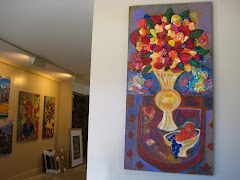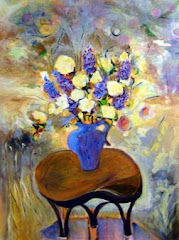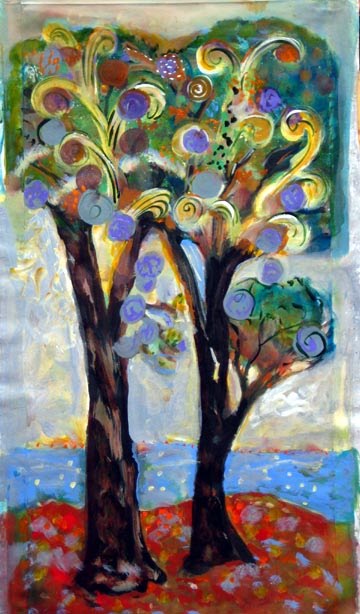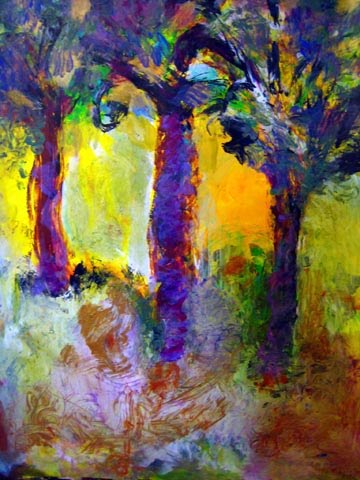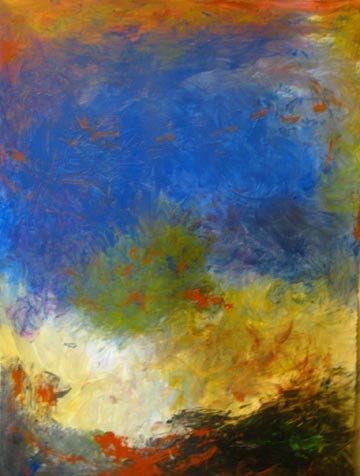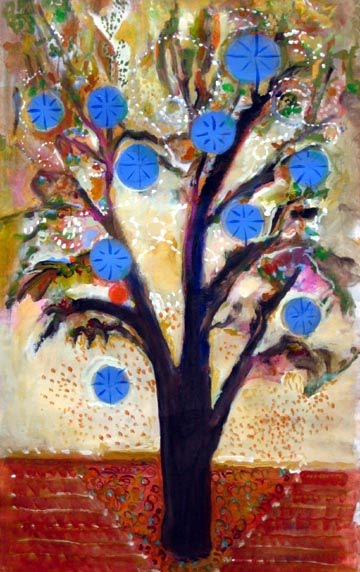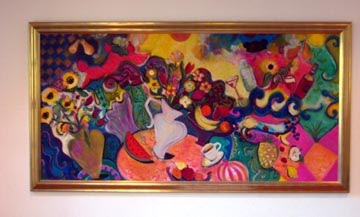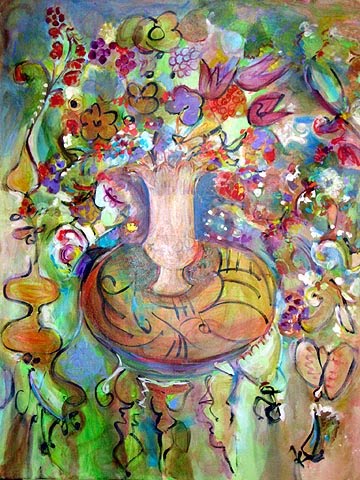Monday, February 28, 2011
Tuesday, February 8, 2011
Acrylic Paint and Collage by Joyce Lieberman
Acrylic Paint and Collage by Joyce Lieberman
What's so great about Acrylic paint is that it can take texture and act as a glue. The French term "Collage' means to cut and paste. It is exciting to reuse and repurpose acrylic paintings that didn't work out well the first time around. there is a wonderful acrylic glue that is great for collage and used for a medium for the paint itself. They range from gloss to matt with satin in between and can be pourable or thick as paste.
I started a large body of collage works I like to call the"Personal Archaeologies" because they were an attempt tot clear off my work table. it seemed like it would take an archaeologist to dig through all the bits of things I found so splendid and saved.
The "Personal Archaeologies" series of collages have been ongoing since 1990. Early versions were in response to great stamps collected from participation in "MAIL ART", ongoing since graduate school in 1980. Work with interior designers left the studio cluttered with bits of fabrics and scraps of paper that seemed to beg for a creative resolution. Parts of monoprints, older paper paintings that didn't quite "Work" and general special pieces of paper from travel and various interests made their way into the fabric like woven surfaces of the collages as I cleared a path through the studio desk top. These collages are like a history and intended to be mood pieces.
Joyce Lieberman
"Spring Essence"
Acrylic and collage on paper
16x14" mounted on 30x22" Stonehenge paper
"Spring Essence" has a cut out crown on top which adds to the irregularity. Again I am using 'edge consciousness' to showcase the beautifully deckled edges of the paper which I have saturated with acrylic paint. It is a very luscious effect.
Another group of collages that I have been working on are mostly painted but have shapes organized and overlapping on them also . That is the 'Venn Diagram Series" which in itself means, overlapping shapes. The Venn Diagram series came from a grade school concept about overlapping sectors. I was experiencing a situation where everyone had a different perspective and was trying to organize where we could intersect with our sensibilities. The Venn diagram came back to me. It is a chart of you and I, and the other and how we can agree, but also have our areas where we don't overlap at all. The materials are acrylic and collage on paper.
http://www.liquitex.com/awardprograms/aotm/200609/artist.cfm
Now that we recognize that acrylics are glue themselves in addition to beautiful color, let me give you some advice about working with these glue like paints.
Never leave your brushes loaded with paint out of the water. Clean the paint off thoroughly with soap and water before leaving them to dry. They will dry to a yucky solid that will render them unusable. I also prefer using jars or bottles of paint rather than paint from tubes. If you put acrylics on your palette, you must use them in the current session, They won't save. They will become plastic hunks of unmanageable yuck. And now my best tip for all acrylic painters. When you get your jars of new paint home to your studio, open them up and put Vaseline on the rim. Yes, Vaseline. The reason is your paint jar will never not open because you have let some paint dry on the rim and the darn thing is glued together. This is very frustrating and worth the attention of putting vaseline on the rims.
Things to make me happy, lots of beautiful paints, things to cut up and jars that open.
Happy painting and collaging.
What's so great about Acrylic paint is that it can take texture and act as a glue. The French term "Collage' means to cut and paste. It is exciting to reuse and repurpose acrylic paintings that didn't work out well the first time around. there is a wonderful acrylic glue that is great for collage and used for a medium for the paint itself. They range from gloss to matt with satin in between and can be pourable or thick as paste.
I started a large body of collage works I like to call the"Personal Archaeologies" because they were an attempt tot clear off my work table. it seemed like it would take an archaeologist to dig through all the bits of things I found so splendid and saved.
The "Personal Archaeologies" series of collages have been ongoing since 1990. Early versions were in response to great stamps collected from participation in "MAIL ART", ongoing since graduate school in 1980. Work with interior designers left the studio cluttered with bits of fabrics and scraps of paper that seemed to beg for a creative resolution. Parts of monoprints, older paper paintings that didn't quite "Work" and general special pieces of paper from travel and various interests made their way into the fabric like woven surfaces of the collages as I cleared a path through the studio desk top. These collages are like a history and intended to be mood pieces.
Joyce Lieberman
"Spring Essence"
Acrylic and collage on paper
16x14" mounted on 30x22" Stonehenge paper
"Spring Essence" has a cut out crown on top which adds to the irregularity. Again I am using 'edge consciousness' to showcase the beautifully deckled edges of the paper which I have saturated with acrylic paint. It is a very luscious effect.
Another group of collages that I have been working on are mostly painted but have shapes organized and overlapping on them also . That is the 'Venn Diagram Series" which in itself means, overlapping shapes. The Venn Diagram series came from a grade school concept about overlapping sectors. I was experiencing a situation where everyone had a different perspective and was trying to organize where we could intersect with our sensibilities. The Venn diagram came back to me. It is a chart of you and I, and the other and how we can agree, but also have our areas where we don't overlap at all. The materials are acrylic and collage on paper.
http://www.liquitex.com/awardprograms/aotm/200609/artist.cfm
Now that we recognize that acrylics are glue themselves in addition to beautiful color, let me give you some advice about working with these glue like paints.
Never leave your brushes loaded with paint out of the water. Clean the paint off thoroughly with soap and water before leaving them to dry. They will dry to a yucky solid that will render them unusable. I also prefer using jars or bottles of paint rather than paint from tubes. If you put acrylics on your palette, you must use them in the current session, They won't save. They will become plastic hunks of unmanageable yuck. And now my best tip for all acrylic painters. When you get your jars of new paint home to your studio, open them up and put Vaseline on the rim. Yes, Vaseline. The reason is your paint jar will never not open because you have let some paint dry on the rim and the darn thing is glued together. This is very frustrating and worth the attention of putting vaseline on the rims.
Things to make me happy, lots of beautiful paints, things to cut up and jars that open.
Happy painting and collaging.
Acrylic Paint and "The UNStill LIfe" by Joyce Lieberman 2/8/2011
Acrylic Paint and "The UNStill LIfe" by Joyce Lieberman 2/8/2011
I love acrylic paint. I have worked with oil, watercolor, gouache and slips on clay. All have their fine traits but for fluidity, speed, layering of color and strength, nothing beats acrylics. In addition to being mixable like oils, they have the flexibility to go from the transparent like watercolor to the opaque like gouache and if mixed right, the luscious full body of oils.
Acrylic can be used on so many surfaces including canvas, paper,and wood. In addition to being a great way to spread and layer color, the paint itself has a glue quality that allow for easy options of collage. My personal favorite surface is Stonehenge Archival paper manufactured now by Legion Paper. http://www.legionpaper.com/stonehenge/Joyce-Lieberman.htm I use Stonehenge as it has a deckle on two sides. I love the edges of the paper, you can see the stacked fibers and it takes acrylic paint really beautifully.
Stonehenge is pretty durable for painting and takes a lot of abuse; water, scratching into with pencils,etc. and also masking with gesso or acrylic paint. If a part of the paper is marked with opaque paint and another part is still unpainted it can be scratched into or incised and then painted with a more watercolor application of acrylics. The original opaque paint acts as a masking for the other watery layers and the contrast is great. It layers beautifully.
I start my works on paper and canvas with an ashe (pronounced ash-AY) which is Japanese for first gesture. I often have a sketch in one hand and a paint brush in the other. These are especially good for the large sizes that seem to require a dancing kind of energy. I put on some music and begin. Lately I have been sponging the surface of the canvas with a color to start, something to work into. Sometimes it's just there to be obliterated later. If I do that, I really start with the layer of color and then begin with a sweeping gesture of the general picture. Drawing is essential here. I try to keep it loose yet with a lot of information in the first few lines which become the bones of the painting.
Acrylics dry swiftly so I don't have to wait too long to begin painting into the first layer and still keep the original color pure. I love patterns and something I call 'edge consciousness'. I love to be mindful of the edges of shapes touching and get involved with the line where that intersection happens. A good example of "edge consciousness' exists between the forms on my diptych "Day and Night UNStill Life", 30x44" acrylic on Stonehenge paper. The shapes are really strong and overlap and intersect. This piece is also a good example of acrylics opacity with a few variations of texture.
Joyce Lieberman
"Night and Day UNStill Life"
Acrylic on Stonehenge paper, 30x44"
The "UNStill Life" has been an ongoing series of mine since 1990. The idea is that the still life is in motion. I like to think about a mobius strip, like a ribbon that is twisted into a continuous loop, instead of a horizon line as the basis for the picture. Life is chaotic ,but if there is a focal point like the flowers on the table, all the patterns and shapes that go to the periphery become manageable. A strong focal point and a sense of motion is the basis of my "UNStill Life" series.
Take the still life and make it swing. Happy Painting.
I love acrylic paint. I have worked with oil, watercolor, gouache and slips on clay. All have their fine traits but for fluidity, speed, layering of color and strength, nothing beats acrylics. In addition to being mixable like oils, they have the flexibility to go from the transparent like watercolor to the opaque like gouache and if mixed right, the luscious full body of oils.
Acrylic can be used on so many surfaces including canvas, paper,and wood. In addition to being a great way to spread and layer color, the paint itself has a glue quality that allow for easy options of collage. My personal favorite surface is Stonehenge Archival paper manufactured now by Legion Paper. http://www.legionpaper.com/stonehenge/Joyce-Lieberman.htm I use Stonehenge as it has a deckle on two sides. I love the edges of the paper, you can see the stacked fibers and it takes acrylic paint really beautifully.
Stonehenge is pretty durable for painting and takes a lot of abuse; water, scratching into with pencils,etc. and also masking with gesso or acrylic paint. If a part of the paper is marked with opaque paint and another part is still unpainted it can be scratched into or incised and then painted with a more watercolor application of acrylics. The original opaque paint acts as a masking for the other watery layers and the contrast is great. It layers beautifully.
I start my works on paper and canvas with an ashe (pronounced ash-AY) which is Japanese for first gesture. I often have a sketch in one hand and a paint brush in the other. These are especially good for the large sizes that seem to require a dancing kind of energy. I put on some music and begin. Lately I have been sponging the surface of the canvas with a color to start, something to work into. Sometimes it's just there to be obliterated later. If I do that, I really start with the layer of color and then begin with a sweeping gesture of the general picture. Drawing is essential here. I try to keep it loose yet with a lot of information in the first few lines which become the bones of the painting.
Acrylics dry swiftly so I don't have to wait too long to begin painting into the first layer and still keep the original color pure. I love patterns and something I call 'edge consciousness'. I love to be mindful of the edges of shapes touching and get involved with the line where that intersection happens. A good example of "edge consciousness' exists between the forms on my diptych "Day and Night UNStill Life", 30x44" acrylic on Stonehenge paper. The shapes are really strong and overlap and intersect. This piece is also a good example of acrylics opacity with a few variations of texture.
Joyce Lieberman
"Night and Day UNStill Life"
Acrylic on Stonehenge paper, 30x44"
The "UNStill Life" has been an ongoing series of mine since 1990. The idea is that the still life is in motion. I like to think about a mobius strip, like a ribbon that is twisted into a continuous loop, instead of a horizon line as the basis for the picture. Life is chaotic ,but if there is a focal point like the flowers on the table, all the patterns and shapes that go to the periphery become manageable. A strong focal point and a sense of motion is the basis of my "UNStill Life" series.
Take the still life and make it swing. Happy Painting.
Subscribe to:
Posts (Atom)


